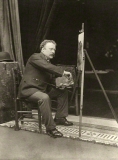Henry Woods
British

The life and art of British painter Henry Woods is one that straddles the precision of his Victorian upbringing in England and vibrancy and inspiration of his adopted home, Venezia. The “pictorial wealth” of this Italian city on water would go on to inform his artistic oeuvre for over forty years.
Henry Woods started his life on Aprill 22nd 1846 in Warrington, whose municipal Art Museum would fortuitously open its doors two years later, offering the young boy a sanctuary dedicated to contemplating his life’s passion, painting. Entering into the Warrington School of Art, Woods’ leisure time was spent absorbing and studying the British Titans of art; the impasto of Reynolds, the subtlety of Gainsborough and the robust humour of Hogarth. Woods befriended Sir Luke Fildes during his earliest studies. The pair moved to London together, where Woods studied on a scholarship for stained glass designing at the South Kensington School of Art. Fortunately, Woods’ notable talent for painting was quickly observed, leading the young pupil to transfer to that métier. It was Woods’ exquisite draughtsmanship and expressive composition that landed him an illustrator position at the Graphic. This illustrated newspaper was a prestigious and influential source in the art world, which included writers like Thomas Hardy and George Eliot and artistic contributions from Luke Fildes, John Millais and Frank Holl, all under the confident direction of founder, Mr. William Thomas.
Nevertheless, it was an Italian grand tour that would dramatically define this artist’s career and life. In 1876, he travelled to Venice and became yet another in a long line of artists, from Carpaccio to Canaletto, Longhi to Turner, to be bewitched by the light and colour of this unique city. In his own words, Woods described the sun setting on La Serenissima as if “the whole visible world, without motion, without sound were dissolving away in a glory and splendour of light and ineffable colour.” As the Italians would say, affare fatto, a done deal. The following year, Woods packed up his life in London and moved to Venice not before exhibiting, to critical acclaim, two paintings of Venetian street scenes at the Royal Academy.
An important note about Woods’ relationship with the city he would paint again and again, was that his understanding of Venice was not only pictorial, he learned the language and spent many an afternoon listing to the haggling and goings on at the Rialto bridge or il mercato or on the traghetto. This fluency and understanding of the Venetian way of life is evident in his work as he has captured the vitality and character of its citizens from an intimate perspective. In many ways, his oeuvre acts as a mirror held up reflecting to later generations the reality of 19th century Venice.




